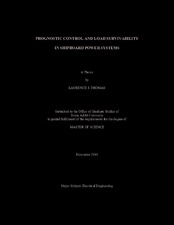| dc.contributor.advisor | Butler-Purry, Dr. Karen L. | |
| dc.creator | Thomas, Laurence J. | |
| dc.date.accessioned | 2011-02-22T22:24:47Z | |
| dc.date.accessioned | 2011-02-22T23:50:33Z | |
| dc.date.available | 2011-02-22T22:24:47Z | |
| dc.date.available | 2011-02-22T23:50:33Z | |
| dc.date.created | 2010-12 | |
| dc.date.issued | 2011-02-22 | |
| dc.date.submitted | December 2010 | |
| dc.identifier.uri | https://hdl.handle.net/1969.1/ETD-TAMU-2010-12-8761 | |
| dc.description.abstract | In shipboard power systems (SPS), it is important to provide continuous power to
vital loads so that their desired missions can be completed successfully. Several
components exist between the primary source and the vital load such as transformers,
cables, or switching devices. These components can fail due to mechanical stresses,
electrical stresses, and overloading which could lead to a system failure. If the normal
path to a vital load cannot supply power to it, then it should be powered through its
alternate path. The process of restoring, balancing, and minimizing power losses to loads
is called network reconfiguration. Prognostics is the ability to predict precisely and
accurately the remaining useful life of a failing component. In this work, the prognostic
information of the power system components is used to determine if reconfiguration
should be performed if the system is unable to accomplish its mission. Each component
will be analyzed using the Weibull Distribution to compute the conditional reliability
from present time to the end of the mission. To determine if reconfiguration is needed, all
components to a given load will be utilized in structure functions to determine if a load
will be able to survive during a time period. Structure functions are used to show how
components are interconnected, and also provide a mathematical means for computing
the total probability of a system. This work will provide a method to compute the
conditional survivability to a given load, and the results indicate the top five loads that
have the lowest conditional survivability during a mission in known configuration. The
results show the computed conditional survivability of loads on an all electric navy ship.
The loads conditional survivability is computed on high/medium voltage level and a low
voltage level to show how loads are affected by failing components along their path. | en |
| dc.format.mimetype | application/pdf | |
| dc.language.iso | en_US | |
| dc.subject | survivability | en |
| dc.subject | prognostics | en |
| dc.subject | reliability | en |
| dc.subject | shipboard | en |
| dc.subject | power system | en |
| dc.title | Prognostic Control and Load Survivability in Shipboard Power Systems | en |
| dc.type | Book | en |
| dc.type | Thesis | en |
| thesis.degree.department | Electrical and Computer Engineering | en |
| thesis.degree.discipline | Electrical Engineering | en |
| thesis.degree.grantor | Texas A&M University | en |
| thesis.degree.name | Master of Science | en |
| thesis.degree.level | Masters | en |
| dc.contributor.committeeMember | Kundur, Dr. Deepa | |
| dc.contributor.committeeMember | Ntaimo, Dr. Lewis | |
| dc.contributor.committeeMember | Singh, Dr. Cannan | |
| dc.type.genre | Electronic Thesis | en |
| dc.type.material | text | en |


